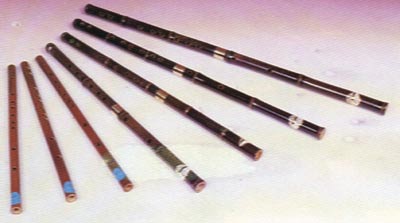 Flute
Flute
 The flute is highly popular with the Chinese people. Due to the natural makings of bamboo, it is also called zhudi, or literally "bamboo flute."
The flute is highly popular with the Chinese people. Due to the natural makings of bamboo, it is also called zhudi, or literally "bamboo flute."
The gnarls in the long bamboo pipe have been eliminated. There are one blowing hole, one affiliated hole, and six sound holes. The blowing hole is the first hole of the flute, where the air is blown in to produce sounds. Next is the affiliated hole, which is covered by the membrane of the bamboo or bulrush. The air makes the membrane vibrate, which can produce clear and smooth tones.
Although the structure of the flute is very simple, it has a history of 7,000 years. About 4,500 years ago, designers began to make flutes with bamboo instead of bone. During the reign of the second emperor of the Han Dynasty in the 1st century BC, the flute was also called hengchui, or literally "blowing horizontally." From the seventh century on, the hole covered by membrane has been used.
With the development of free verse of the Song Dynasty (960-1279) and the music of theYuan Dynasty(1271-1368), the flute became the main part of the accompaniment, and was also indispensable in folk and ethnic dramas.
The flute has a rich performance spectrum. Not only can it play loud and sonorous tunes, but also cheerful dancing music and peaceful ditties. In addition, it can imitate various sounds in nature such as the twittering of birds.
There are many kinds of flutes, such as those with seven or 11 holes, and those with keys. They are divided into two groups according to their different styles. The qudi, another kind of flute, which is popular mainly in the southern part of theYangtze River, represents the southern group, which sounds clear and elegant. The northern style, by contrast, is rough and powerful and is popular mostly in North China.
